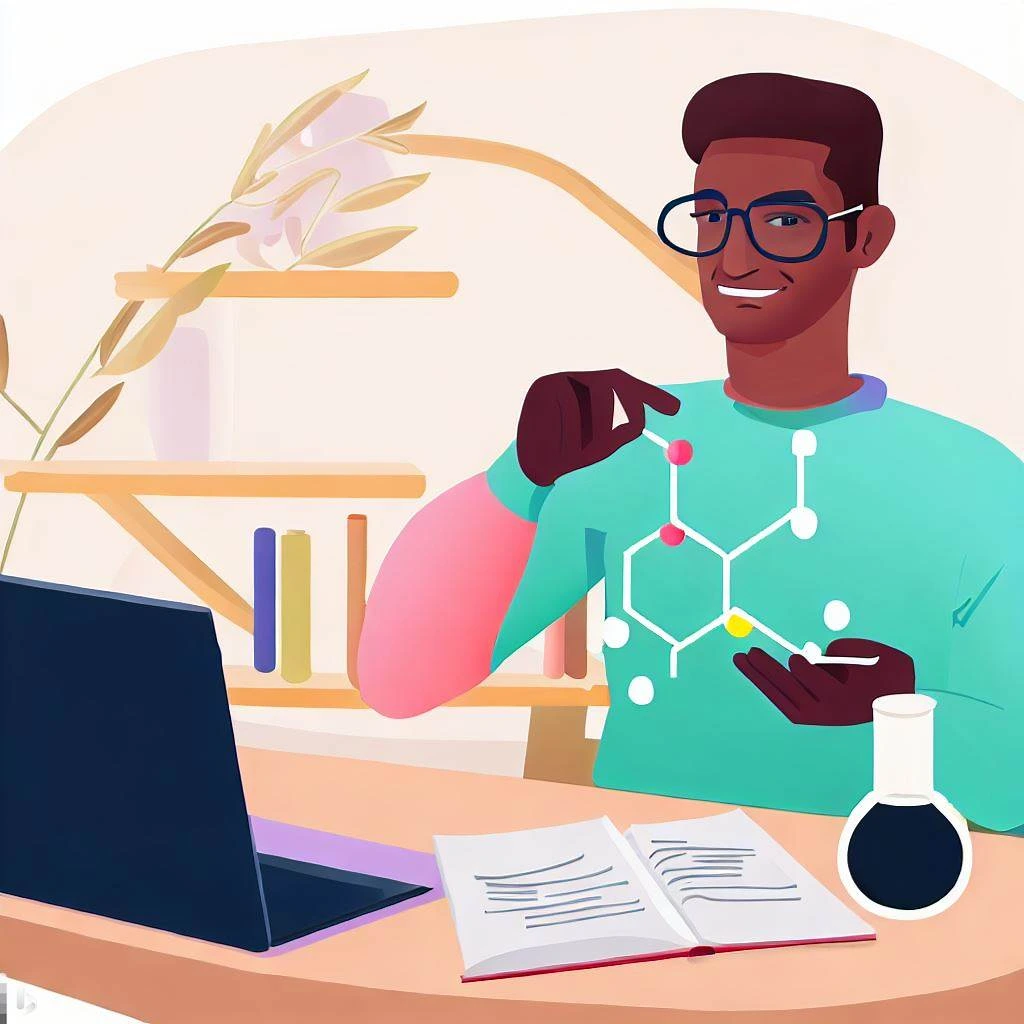Exploring the World of Inorganic Chemistry: How to Tackle Assignments with Ease

A fascinating area of chemistry called inorganic chemistry explores the characteristics and actions of inorganic compounds or things without carbon-hydrogen bonds. The study of elements, their compounds, and the reactions they go through are all included in this field. Assignments are a significant part of the curriculum for students studying inorganic chemistry. However, approaching these assignments can occasionally be difficult. We will embark on a thorough investigation of the field of inorganic chemistry in this blog post, giving you insightful knowledge and useful advice on how to successfully complete your assignments.
Recognizing the Basics of Inorganic Chemistry:
It is essential to gain a firm grasp of the fundamentals in order to successfully negotiate the challenging terrain of inorganic chemistry assignments. The periodic table, chemical bonds, molecular structures, and various types of reactions are all topics covered by inorganic chemistry. It is crucial to become familiar with these fundamental ideas so that you can approach assignments with confidence. A solid understanding of these foundational concepts will enable you to solve challenging puzzles and give assignments clear direction.

Dissecting the Assignment:
It is crucial to divide large inorganic chemistry assignments into smaller, more manageable tasks. Carefully examine the requirements, highlighting the crucial elements that require attention. You can outline the steps needed to complete each task by creating a checklist or an outline. This strategy not only aids in thought organization but also enables you to work on one task at a time, reducing the overall burden of the assignment.
Research and Information Gathering:
For inorganic chemistry assignments, extensive research is frequently required. Utilize the wealth of resources at your disposal, including reputable websites, online databases, scientific journals, and textbooks. Start a methodical process of gathering information and diligently compiling relevant information. Make thorough notes on key ideas, reactions, and theories related to the subject of your assignment. Your ability to quickly access your research materials while working on your chemistry assignment will improve the quality and breadth of your analysis.
Consult the lecture notes and course materials:
It is essential to review your course materials and lecture notes in addition to outside resources. During lectures, professors share insightful information and frequently clarify important theories and methodologies. Make sure your assignment incorporates the key ideas covered in class by reviewing your class notes and the pertinent chapters in your textbook. By seamlessly fusing theory and practice, this shows that you have a thorough understanding of the course material and gives you the advantage in your assignments.
Making a Plan and Choosing Realistic Objectives:
Making a well-organized plan and choosing reasonable goals are essential for successfully finishing your assignments. Set aside time each day to do research, think through problems, and write. You can stay on track and avoid the dangers of last-minute rush by breaking your work up into manageable tasks and assigning deadlines for each task. You can more efficiently manage your time and produce high-quality assignments that adhere to the requirements by creating a clearly defined timeline.
Solving Practice Issues:
Inorganic chemistry is no different in that practice is the key to mastery. Engaging in the methodical solution of practice problems related to the subject of your assignment can greatly improve your comprehension and hone your problem-solving abilities. Many textbooks and online resources provide sample problems and practice questions that are catered to various levels of complexity. Invest the time necessary to complete these exercises because doing so builds your confidence and gives you the tools you need to solve similar issues in your assignment. Your ability to handle complex assignments improves with practice, ensuring your continued success and growth.
Request Clarification and Assistance:
Do not be afraid to ask for clarification if you are having trouble or are harboring doubts about your assignment. To gain understanding and dispel any uncertainties that might hinder your progress, speak with your professor or teaching assistant. Because inorganic chemistry can be complicated, it is wise and indicative of proactive learning to ask for help when you need it. You can avoid misunderstandings and create a clearer path to successfully completing your assignment by promptly addressing any areas of uncertainty or confusion. Keep in mind that asking for assistance is not a sign of weakness but rather of your dedication to mastering and doing well in your coursework.
You can master the complexities of this fascinating field by using these techniques and taking a systematic approach to your inorganic chemistry assignments. Knowing that each assignment you complete moves you one step closer to learning the secrets of the fascinating world of inorganic chemistry, embrace the challenges as chances for growth and exploration.
Using Models and Visualization Tools:
Complex architectures and intricate molecular arrangements are frequent features of inorganic chemistry. It is advantageous to use various visualization tools and models to help understand and visualize these structures. To better understand the spatial arrangements and bonding patterns of molecules, you can create three-dimensional representations of them using molecular modeling software like ChemDraw or Avogadro. Additionally, physical models offer a hands-on way to investigate molecular structures, such as molecular model kits. You can improve your comprehension of inorganic compounds, pinpoint important characteristics, and effectively communicate your conclusions in assignments or presentations by using these tools.
Spectroscopic Techniques Integration:
Spectroscopic methods are essential to the study of inorganic chemistry because they shed light on the characteristics and behavior of compounds. Electronic transitions, molecular vibrations, and atomic interactions can all be studied using methods like UV-Vis spectroscopy, infrared spectroscopy, and nuclear magnetic resonance (NMR) spectroscopy, respectively. Understanding the underlying theories of these techniques and how to interpret the results are essential when approaching assignments involving spectroscopic analysis. Learn how to interpret spectra and become familiar with the various spectroscopic techniques used in inorganic chemistry. You can provide a thorough analysis of the compounds under investigation and make accurate conclusions based on experimental data by including spectroscopic techniques in your assignments.
Coordination Chemistry: An Exploration:
The study of coordination compounds, which have a central metal ion or atom coordinated to ligands, is the main focus of coordination chemistry. These substances have distinctive properties and are essential in many disciplines, such as catalysis, bioinorganic chemistry, and materials science. Understanding ideas like coordination numbers, isomerism, ligand field theory, and coordination geometries is crucial when working on assignments involving coordination chemistry. Examine the various ligand types and the ways in which they bond, as well as the variables that affect the stability and reactivity of coordination compounds. You can better understand the complexities of these fascinating compounds and successfully complete assignment tasks relating to their synthesis, characterization, and applications by exploring the field of coordination chemistry.
investigating the chemistry of organometallics:
The interactions between organic compounds and metal ions or atoms are examined in organometallic chemistry. Aspects of both organic and inorganic chemistry are combined in this interdisciplinary field, which results in the discovery of new compounds and catalytic systems. Understanding the bonding and reactivity of organometallic compounds, including metal-carbon sigma and pi bonds, is essential when approaching assignments in organometallic chemistry. Examine the various types of reactions that organometallic compounds can go through, such as oxidative addition, reductive elimination, and migratory insertion. Additionally, look into how organometallic catalysts are used in various chemical reactions. You can complete assignments involving the synthesis, characterization, and applications of these compounds by immersing yourself in the field of organometallic chemistry, demonstrating a thorough understanding of their special characteristics and potential.
Addressing Inorganic Chemistry's Environmental Applications:
When it comes to solving environmental problems, including cleaning up pollution and producing sustainable energy, inorganic chemistry is crucial. It is essential to investigate subjects like catalytic converters, photocatalysis, and the creation of materials for energy storage when working on assignments that concentrate on the environmental applications of inorganic chemistry. Examine the guiding principles of these technologies and how they affect the reduction of environmental problems. Recognize the methods used to degrade pollutants, such as the function played by transition metal complexes in catalytic processes. Additionally, look into developments in the production of renewable energy, such as the creation of inorganic materials for fuel cells and solar cells. While tackling the assignment tasks with a thorough understanding of the underlying principles and technologies, you can contribute to the ongoing efforts to create a sustainable and cleaner world by exploring the environmental applications of inorganic chemistry.
Conclusion:
The investigation of elements, their compounds, and their reactions is the focus of the fascinating field known as inorganic chemistry. While inorganic chemistry assignments can initially seem difficult, with the proper approach and techniques, you can complete them without difficulty. You can improve your comprehension of difficult concepts and successfully complete each task by grasping the fundamentals, breaking down assignments, conducting in-depth research, using visualization tools and models, and breaking down assignments. Utilizing spectroscopic methods, learning about coordination and organometallic chemistry, and researching the uses of inorganic chemistry in the environment all add to your knowledge and help you approach assignments from various perspectives.
We have emphasized the value of asking for clarification, seeking assistance when necessary, and practicing problem-solving throughout this blog post. There may be challenges along the way because inorganic chemistry can be complicated. By asking your professors, teaching assistants, and fellow students for help, you can be sure that you'll get the direction you need to overcome obstacles and perform well on your assignments. Additionally, working through practice problems and actively putting the concepts you've learned in class to use will help you become more confident and improve your problem-solving abilities.